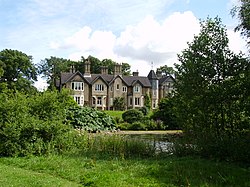| York Cottage | |
|---|---|
 | |
 | |
| Former names | Bachelors' Cottage |
| General information | |
| Town or city | Sandringham Estate, Norfolk |
| Country | United Kingdom |
| Current tenants | Sandringham offices |
| Owner | Charles III |
York Cottage is a house in the grounds of Sandringham House in Norfolk, England.[1]
History[edit]
The cottage was originally called the Bachelor's Cottage, and built as an overflow residence for Sandringham House.[2]
In 1893, it was given by the future King Edward VII, then the Prince of Wales, as a wedding gift to his son Prince George, the Duke of York (later King George V),[1] who lived there with his wife, the future Queen Mary, after their marriage.[3] The couple lived there for 33 years until the death of Queen Alexandra in 1925;[4] their five youngest children were born there.[1]
George V loved York Cottage, which is said to resemble "three Merrie England pubs joined together." He furnished it himself with furniture purchased from Maple & Co. furniture store. "Too large and too full of footmen to be unremarkable in Surbiton or Upper Norwood, York Cottage in its own context is a monument to the eccentricity of the family who lived there," Lady Donaldson wrote of the cottage.[4]
Today, York Cottage is the estate office for Sandringham; holiday accommodation and flats for estate employees also occupy part of the building.[4]
52°49′35″N 0°30′58″E / 52.8263°N 0.5162°E
References[edit]
- ^ a b c "Norfolk Coast". Archived from the original on 18 March 2012. Retrieved 3 December 2012.
- ^ Duke of Windsor (8 December 1947). "A Royal Boyhood". Life Magazine: 118. Retrieved 31 March 2015.
- ^ "York Cottage". Retrieved 3 December 2012.
- ^ a b c Strong, Sir Roy (2 April 2013). "A home fit to make Royal family history". The Daily Telegraph. Retrieved 31 March 2015.
Well, that’s interesting to know that Psilotum nudum are known as whisk ferns. Psilotum nudum is the commoner species of the two. While the P. flaccidum is a rare species and is found in the tropical islands. Both the species are usually epiphytic in habit and grow upon tree ferns. These species may also be terrestrial and grow in humus or in the crevices of the rocks.
View the detailed Guide of Psilotum nudum: Detailed Study Of Psilotum Nudum (Whisk Fern), Classification, Anatomy, Reproduction